parking brake TOYOTA SUPRA 1995 Service Repair Manual
[x] Cancel search | Manufacturer: TOYOTA, Model Year: 1995, Model line: SUPRA, Model: TOYOTA SUPRA 1995Pages: 2543, PDF Size: 53.25 MB
Page 427 of 2543
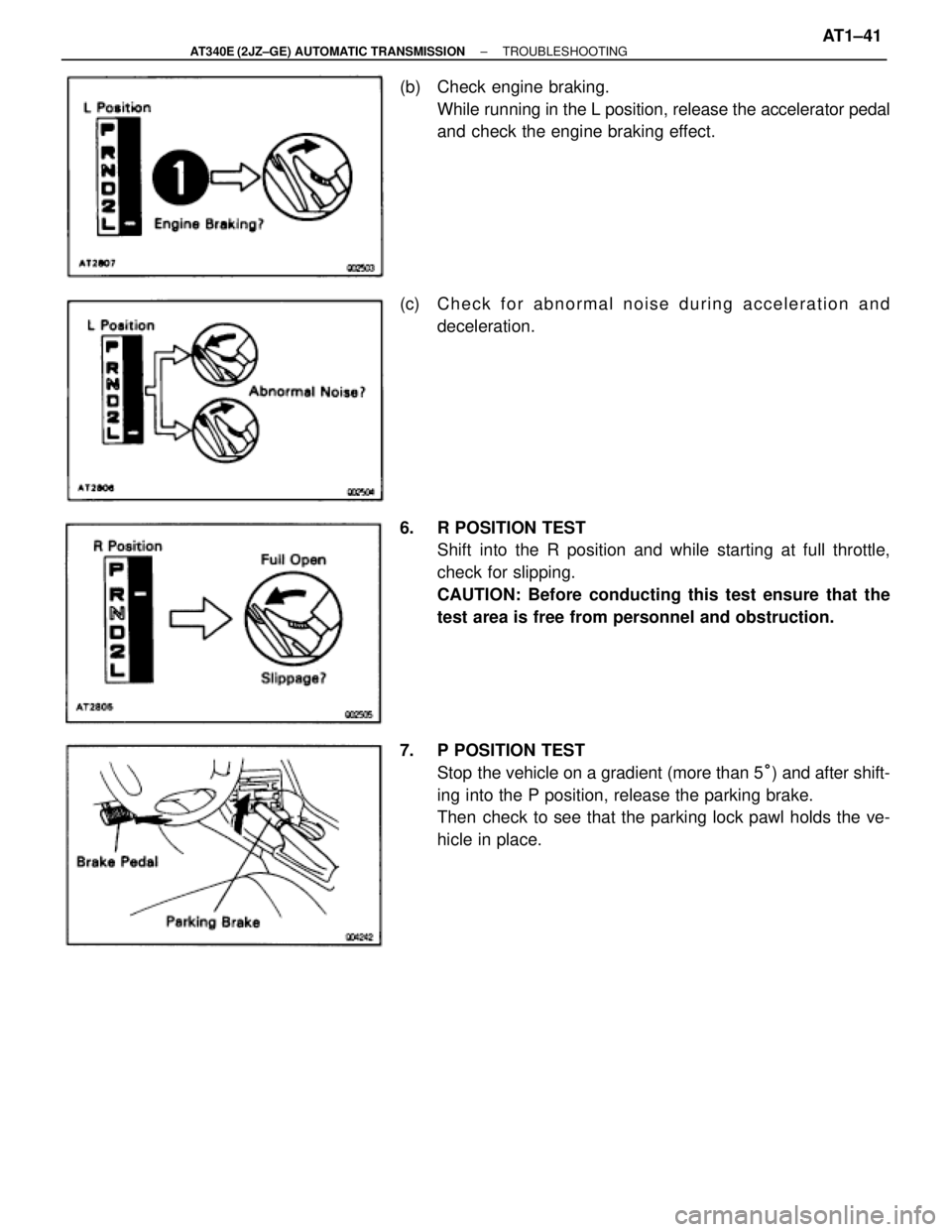
(b) Check engine braking.
While running in the L position, release the accelerator pedal
and check the engine braking effect.
(c) C h e c k f o r abnormal noise during acceleration and
deceleration.
6. R POSITION TEST
Shift into the R position and while starting at full throttle,
check for slipping.
CAUTION: Before conducting this test ensure that the
test area is free from personnel and obstruction.
7. P POSITION TEST
Stop the vehicle on a gradient (more than 5°) and after shift-
ing into the P position, release the parking brake.
Then check to see that the parking lock pawl holds the ve-
hicle in place.
± AT340E (2JZ±GE) AUTOMATIC TRANSMISSIONTROUBLESHOOTINGAT1±41
Page 428 of 2543
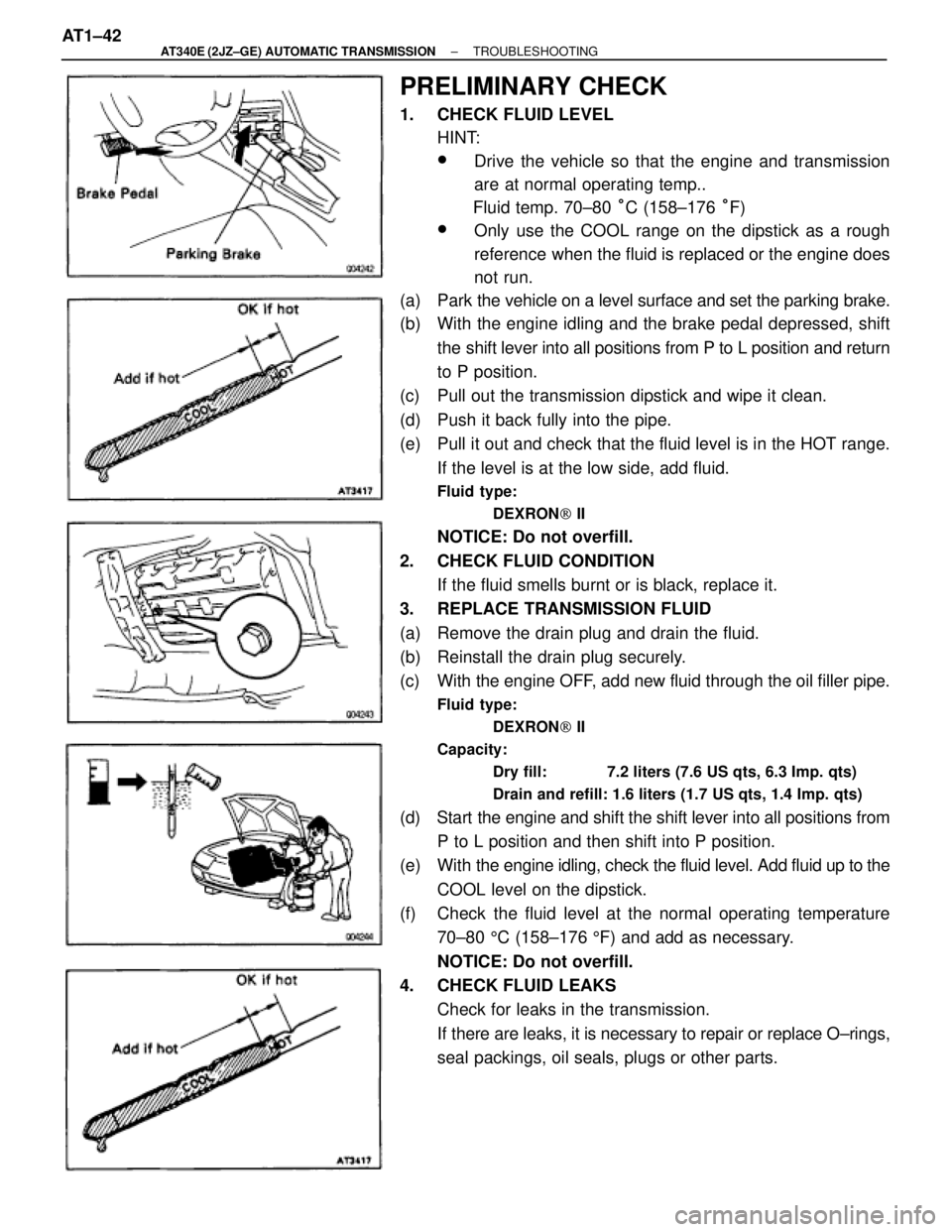
PRELIMINARY CHECK
1. CHECK FLUID LEVEL
HINT:
wDrive the vehicle so that the engine and transmission
are at normal operating temp..
Fluid temp. 70±80 °C (158±176 °F)
wOnly use the COOL range on the dipstick as a rough
reference when the fluid is replaced or the engine does
not run.
(a) Park the vehicle on a level surface and set the parking brake.
(b) With the engine idling and the brake pedal depressed, shift
the shift lever into all positions from P to L position and return
to P position.
(c) Pull out the transmission dipstick and wipe it clean.
(d) Push it back fully into the pipe.
(e) Pull it out and check that the fluid level is in the HOT range.
If the level is at the low side, add fluid.
Fluid type:
DEXRON[ II
NOTICE: Do not overfill.
2. CHECK FLUID CONDITION
If the fluid smells burnt or is black, replace it.
3. REPLACE TRANSMISSION FLUID
(a) Remove the drain plug and drain the fluid.
(b) Reinstall the drain plug securely.
(c) With the engine OFF, add new fluid through the oil filler pipe.
Fluid type:
DEXRON[ II
Capacity:
Dry fill: 7.2 liters (7.6 US qts, 6.3 Imp. qts)
Drain and refill: 1.6 liters (1.7 US qts, 1.4 Imp. qts)
(d) Start the engine and shift the shift lever into all positions from
P to L position and then shift into P position.
(e) With the engine idling, check the fluid level. Add fluid up to the
COOL level on the dipstick.
(f) Check the fluid level at the normal operating temperature
70±80 5C (158±176 5F) and add as necessary.
NOTICE: Do not overfill.
4. CHECK FLUID LEAKS
Check for leaks in the transmission.
If there are leaks, it is necessary to repair or replace O±rings,
seal packings, oil seals, plugs or other parts. AT1±42
± AT340E (2JZ±GE) AUTOMATIC TRANSMISSIONTROUBLESHOOTING
Page 430 of 2543
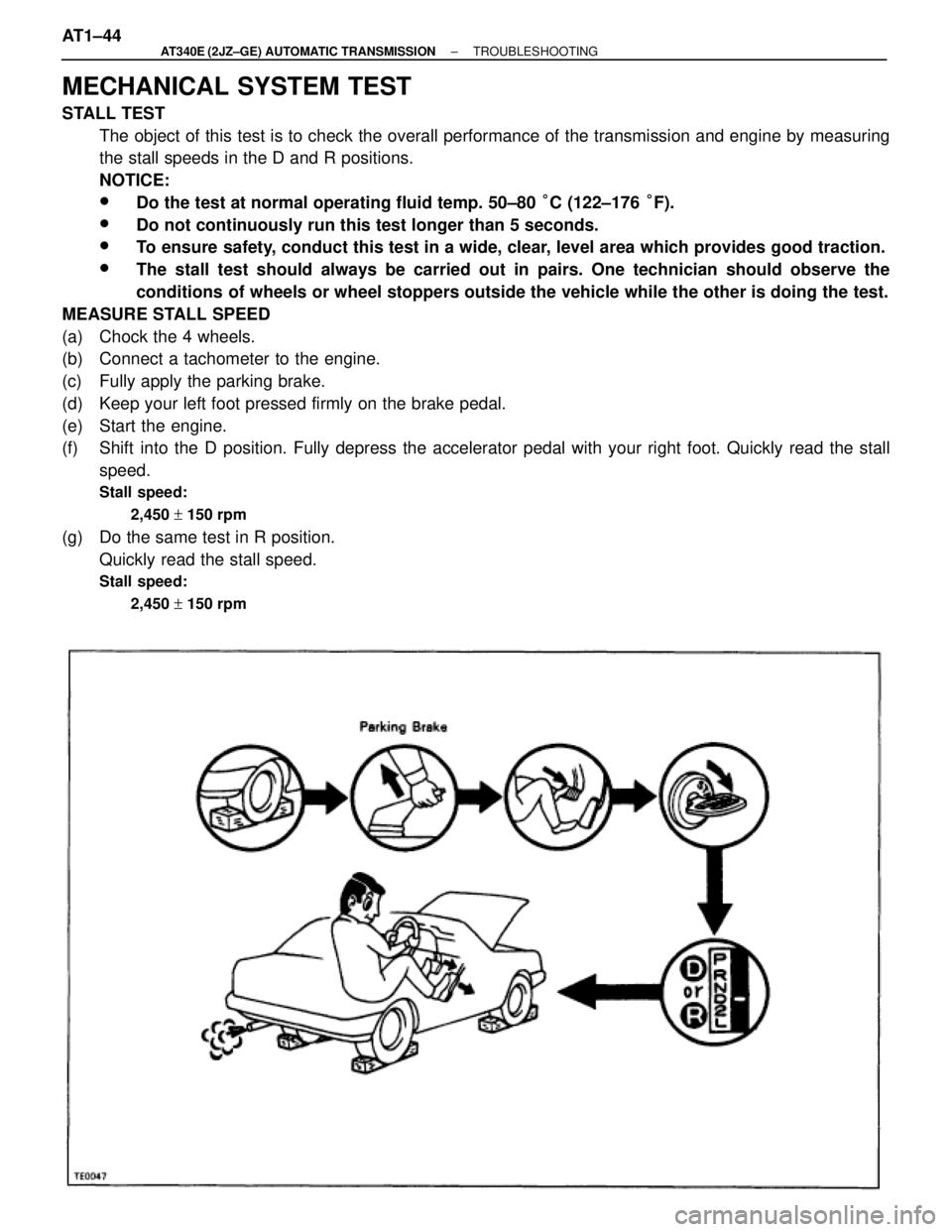
MECHANICAL SYSTEM TEST
STALL TEST
The object of this test is to check the overall performance of the transmission and engine by measuring
the stall speeds in the D and R positions.
NOTICE:
wDo the test at normal operating fluid temp. 50±80 °C (122±176 °F).
wDo not continuously run this test longer than 5 seconds.
wTo ensure safety, conduct this test in a wide, clear, level area which provides good traction.
wThe stall test should always be carried out in pairs. One technician should observe the
conditions of wheels or wheel stoppers outside the vehicle while the other is doing the test.
MEASURE STALL SPEED
(a) Chock the 4 wheels.
(b) Connect a tachometer to the engine.
(c) Fully apply the parking brake.
(d) Keep your left foot pressed firmly on the brake pedal.
(e) Start the engine.
(f) Shift into the D position. Fully depress the accelerator pedal with your right foot. Quickly read the stall
speed.
Stall speed:
2,450 + 150 rpm
(g) Do the same test in R position.
Quickly read the stall speed.
Stall speed:
2,450 + 150 rpm
AT1±44± AT340E (2JZ±GE) AUTOMATIC TRANSMISSIONTROUBLESHOOTING
Page 432 of 2543
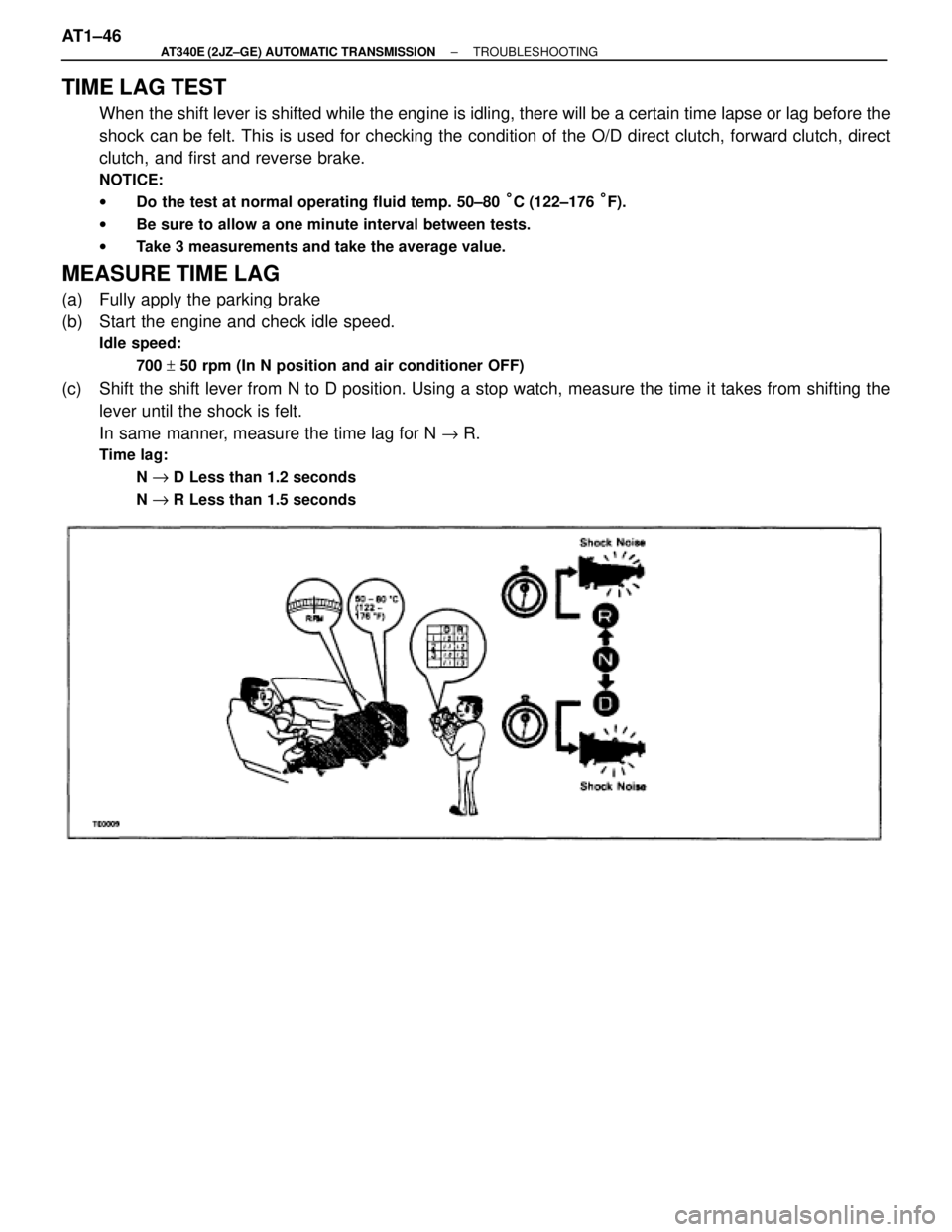
TIME LAG TEST
When the shift lever is shifted while the engine is idling, there will be a certain time lapse or lag before the
shock can be felt. This is used for checking the condition of the O/D direct clutch, forward clutch, direct
clutch, and first and reverse brake.
NOTICE:
wDo the test at normal operating fluid temp. 50±80
°C (122±176 °F).
wBe sure to allow a one minute interval between tests.
wTake 3 measurements and take the average value.
MEASURE TIME LAG
(a) Fully apply the parking brake
(b) Start the engine and check idle speed.
Idle speed:
700 + 50 rpm (In N position and air conditioner OFF)
(c) Shift the shift lever from N to D position. Using a stop watch, measure the time it takes from shifting the
lever until the shock is felt.
In same manner, measure the time lag for N " R.
Time lag:
N
" D Less than 1.2 seconds
N
" R Less than 1.5 seconds
AT1±46± AT340E (2JZ±GE) AUTOMATIC TRANSMISSIONTROUBLESHOOTING
Page 434 of 2543
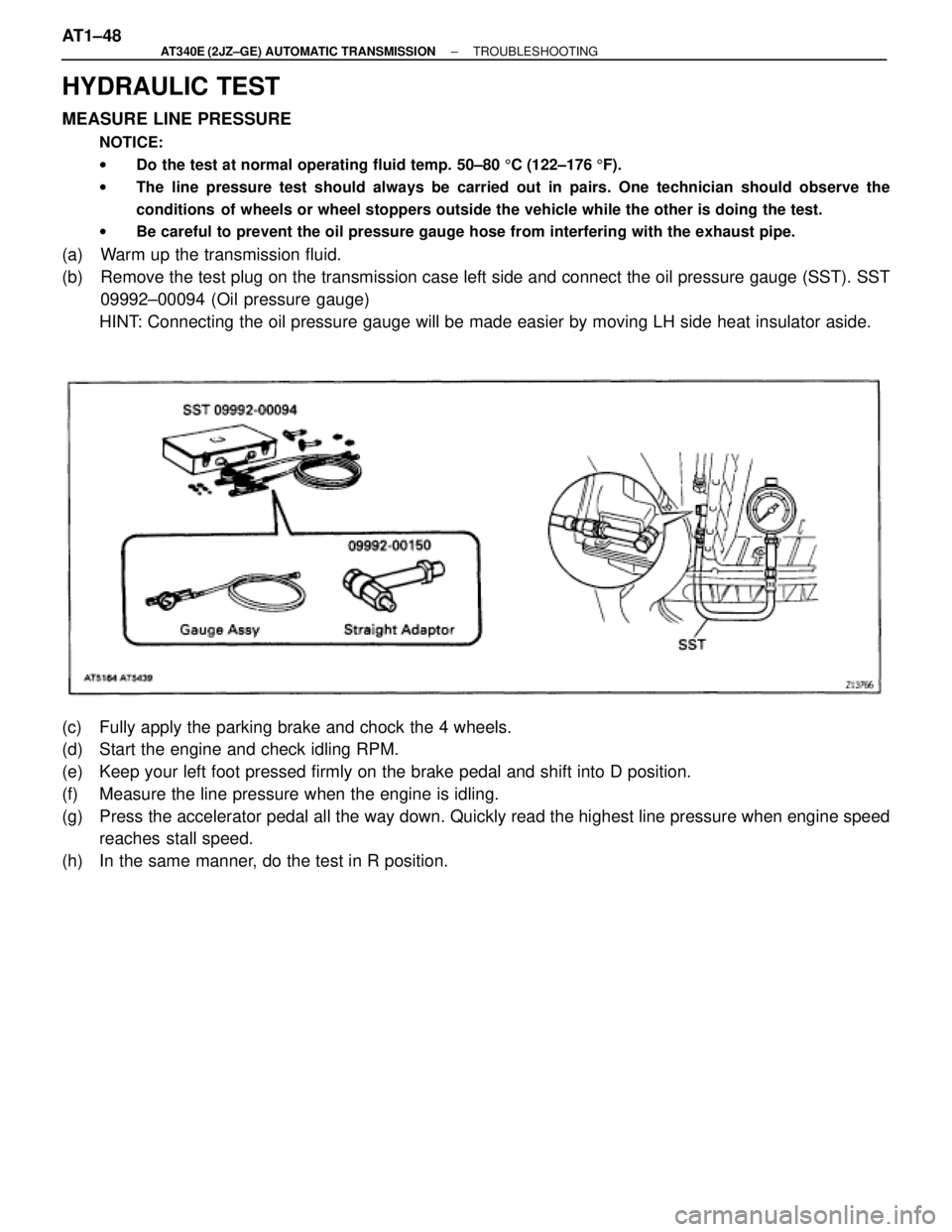
HYDRAULIC TEST
MEASURE LINE PRESSURE
NOTICE:
wDo the test at normal operating fluid temp. 50±80 5C (122±176 5F).
wThe line pressure test should always be carried out in pairs. One technician should observe the
conditions of wheels or wheel stoppers outside the vehicle while the other is doing the test.
wBe careful to prevent the oil pressure gauge hose from interfering with the exhaust pipe.
(a) Warm up the transmission fluid.
(b) Remove the test plug on the transmission case left side and connect the oil pressure gauge (SST). SST
09992±00094 (Oil pressure gauge)
HINT: Connecting the oil pressure gauge will be made easier by moving LH side heat insulator aside.
(c) Fully apply the parking brake and chock the 4 wheels.
(d) Start the engine and check idling RPM.
(e) Keep your left foot pressed firmly on the brake pedal and shift into D position.
(f) Measure the line pressure when the engine is idling.
(g) Press the accelerator pedal all the way down. Quickly read the highest line pressure when engine speed
reaches stall speed.
(h) In the same manner, do the test in R position. AT1±48
± AT340E (2JZ±GE) AUTOMATIC TRANSMISSIONTROUBLESHOOTING
Page 525 of 2543
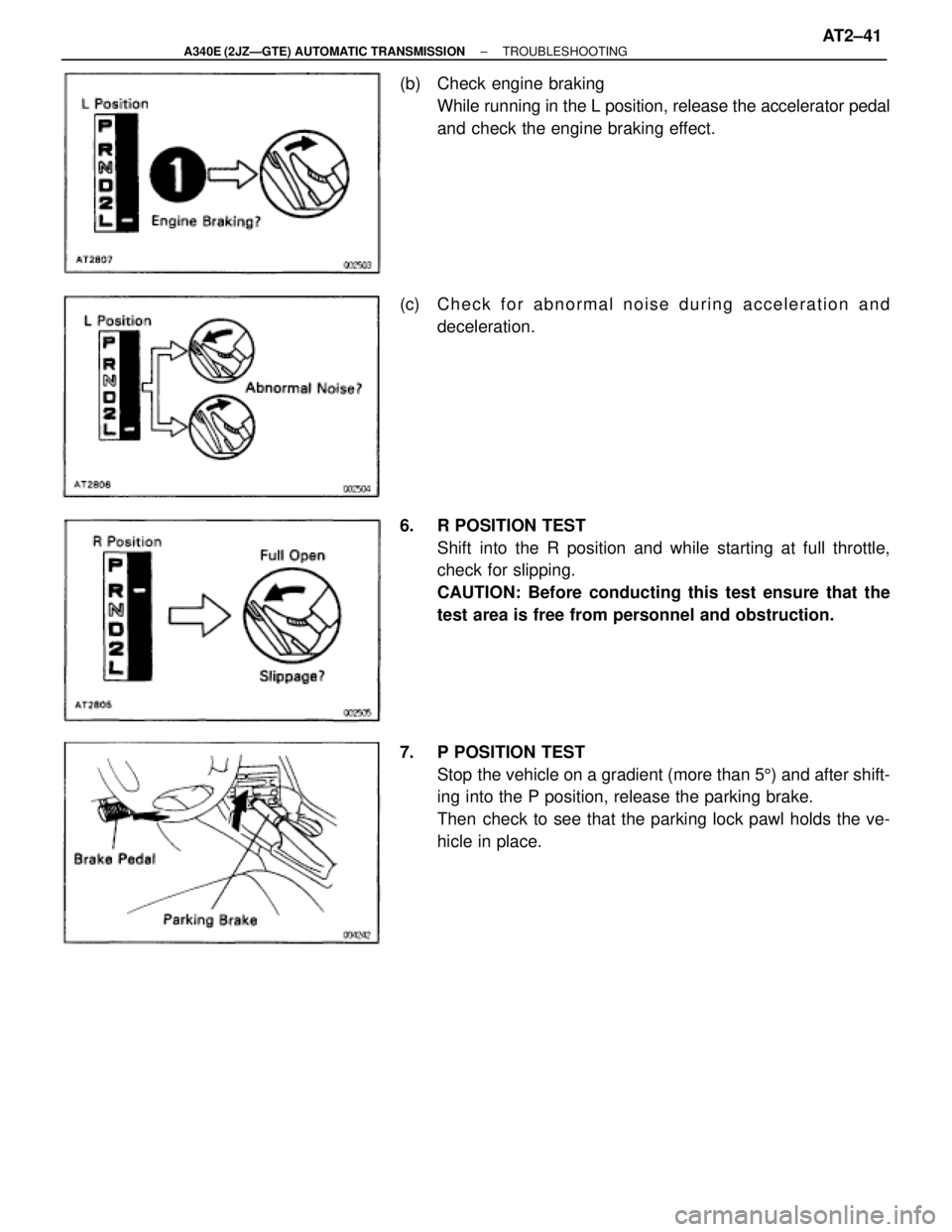
(b) Check engine braking
While running in the L position, release the accelerator pedal
and check the engine braking effect.
(c) C h e c k f o r abnormal noise during acceleration and
deceleration.
6. R POSITION TEST
Shift into the R position and while starting at full throttle,
check for slipping.
CAUTION: Before conducting this test ensure that the
test area is free from personnel and obstruction.
7. P POSITION TEST
Stop the vehicle on a gradient (more than 55) and after shift-
ing into the P position, release the parking brake.
Then check to see that the parking lock pawl holds the ve-
hicle in place.
± A340E (2JZÐGTE) AUTOMATIC TRANSMISSIONTROUBLESHOOTINGAT2±41
Page 526 of 2543
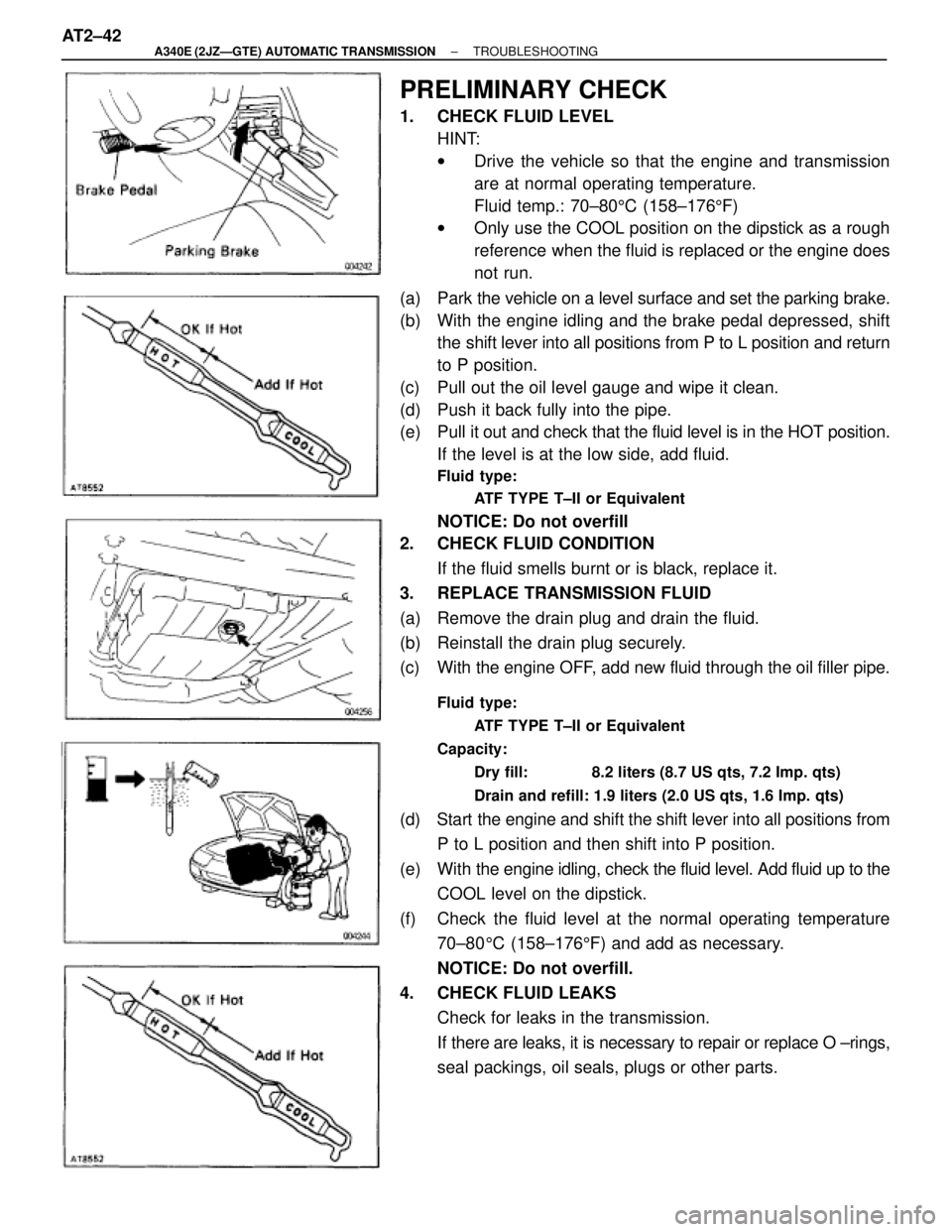
PRELIMINARY CHECK
1. CHECK FLUID LEVEL
HINT:
wDrive the vehicle so that the engine and transmission
are at normal operating temperature.
Fluid temp.: 70±805C (158±1765F)
wOnly use the COOL position on the dipstick as a rough
reference when the fluid is replaced or the engine does
not run.
(a) Park the vehicle on a level surface and set the parking brake.
(b) With the engine idling and the brake pedal depressed, shift
the shift lever into all positions from P to L position and return
to P position.
(c) Pull out the oil level gauge and wipe it clean.
(d) Push it back fully into the pipe.
(e) Pull it out and check that the fluid level is in the HOT position.
If the level is at the low side, add fluid.
Fluid type:
ATF TYPE T±II or Equivalent
NOTICE: Do not overfill
2. CHECK FLUID CONDITION
If the fluid smells burnt or is black, replace it.
3. REPLACE TRANSMISSION FLUID
(a) Remove the drain plug and drain the fluid.
(b) Reinstall the drain plug securely.
(c) With the engine OFF, add new fluid through the oil filler pipe.
Fluid type:
ATF TYPE T±II or Equivalent
Capacity:
Dry fill: 8.2 liters (8.7 US qts, 7.2 Imp. qts)
Drain and refill: 1.9 liters (2.0 US qts, 1.6 Imp. qts)
(d) Start the engine and shift the shift lever into all positions from
P to L position and then shift into P position.
(e) With the engine idling, check the fluid level. Add fluid up to the
COOL level on the dipstick.
(f) Check the fluid level at the normal operating temperature
70±805C (158±1765F) and add as necessary.
NOTICE: Do not overfill.
4. CHECK FLUID LEAKS
Check for leaks in the transmission.
If there are leaks, it is necessary to repair or replace O ±rings,
seal packings, oil seals, plugs or other parts. AT2±42
± A340E (2JZÐGTE) AUTOMATIC TRANSMISSIONTROUBLESHOOTING
Page 528 of 2543
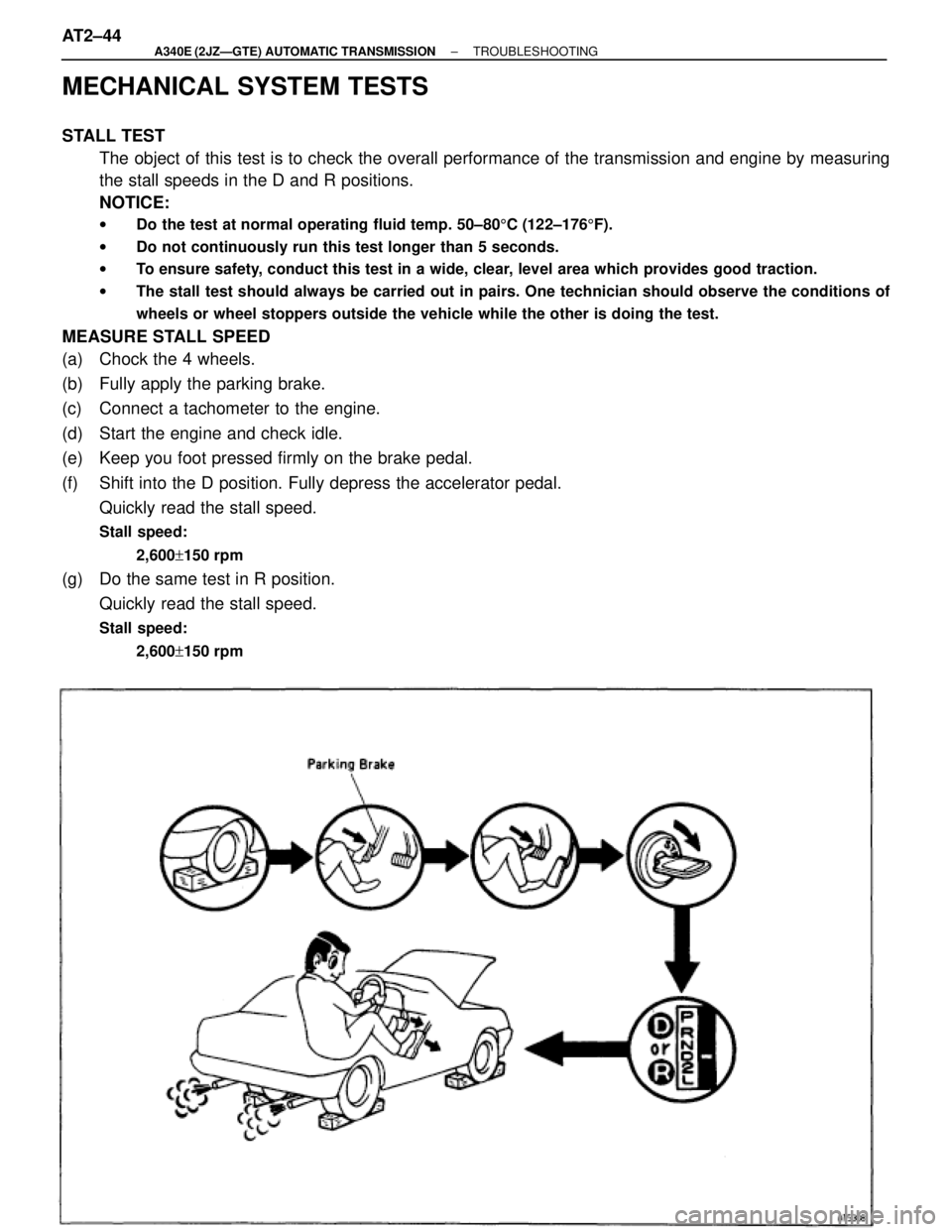
MECHANICAL SYSTEM TESTS
STALL TEST
The object of this test is to check the overall performance of the transmission and engine by measuring
the stall speeds in the D and R positions.
NOTICE:
wDo the test at normal operating fluid temp. 50±805C (122±1765F).
wDo not continuously run this test longer than 5 seconds.
wTo ensure safety, conduct this test in a wide, clear, level area which provides good traction.
wThe stall test should always be carried out in pairs. One technician should observe the conditions of
wheels or wheel stoppers outside the vehicle while the other is doing the test.
MEASURE STALL SPEED
(a) Chock the 4 wheels.
(b) Fully apply the parking brake.
(c) Connect a tachometer to the engine.
(d) Start the engine and check idle.
(e) Keep you foot pressed firmly on the brake pedal.
(f) Shift into the D position. Fully depress the accelerator pedal.
Quickly read the stall speed.
Stall speed:
2,600+150 rpm
(g) Do the same test in R position.
Quickly read the stall speed.
Stall speed:
2,600+150 rpm
AT2±44± A340E (2JZÐGTE) AUTOMATIC TRANSMISSIONTROUBLESHOOTING
Page 530 of 2543
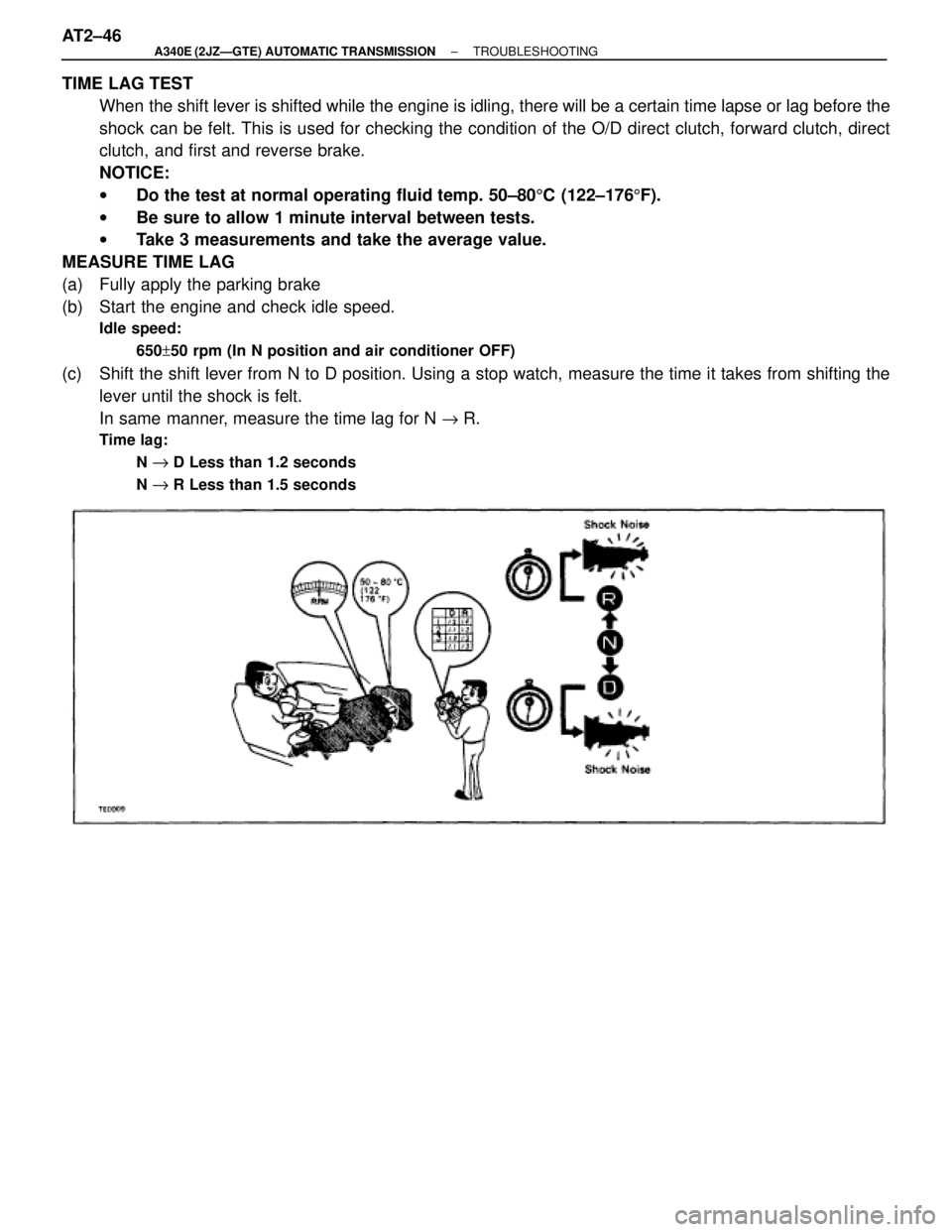
TIME LAG TEST
When the shift lever is shifted while the engine is idling, there will be a certain time lapse or lag before the
shock can be felt. This is used for checking the condition of the O/D direct clutch, forward clutch, direct
clutch, and first and reverse brake.
NOTICE:
wDo the test at normal operating fluid temp. 50±805C (122±1765F).
wBe sure to allow 1 minute interval between tests.
wTake 3 measurements and take the average value.
MEASURE TIME LAG
(a) Fully apply the parking brake
(b) Start the engine and check idle speed.
Idle speed:
650+50 rpm (In N position and air conditioner OFF)
(c) Shift the shift lever from N to D position. Using a stop watch, measure the time it takes from shifting the
lever until the shock is felt.
In same manner, measure the time lag for N " R.
Time lag:
N
"D Less than 1.2 seconds
N
"R Less than 1.5 seconds
AT2±46± A340E (2JZÐGTE) AUTOMATIC TRANSMISSIONTROUBLESHOOTING
Page 532 of 2543
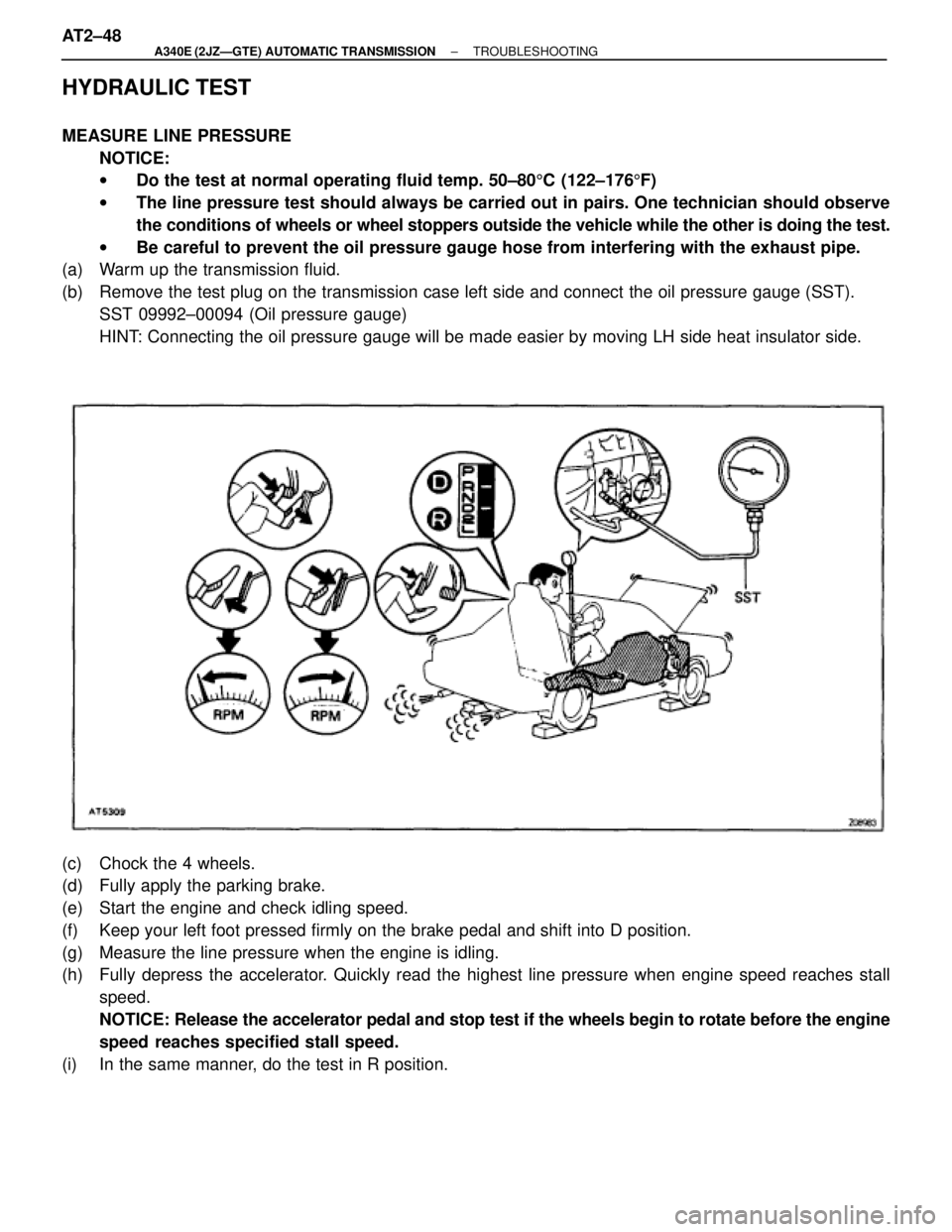
HYDRAULIC TEST
MEASURE LINE PRESSURE
NOTICE:
wDo the test at normal operating fluid temp. 50±805C (122±1765F)
wThe line pressure test should always be carried out in pairs. One technician should observe
the conditions of wheels or wheel stoppers outside the vehicle while the other is doing the test.
wBe careful to prevent the oil pressure gauge hose from interfering with the exhaust pipe.
(a) Warm up the transmission fluid.
(b) Remove the test plug on the transmission case left side and connect the oil pressure gauge (SST).
SST 09992±00094 (Oil pressure gauge)
HINT: Connecting the oil pressure gauge will be made easier by moving LH side heat insulator side.
(c) Chock the 4 wheels.
(d) Fully apply the parking brake.
(e) Start the engine and check idling speed.
(f) Keep your left foot pressed firmly on the brake pedal and shift into D position.
(g) Measure the line pressure when the engine is idling.
(h) Fully depress the accelerator. Quickly read the highest line pressure when engine speed reaches stall
speed.
NOTICE: Release the accelerator pedal and stop test if the wheels begin to rotate before the engine
speed reaches specified stall speed.
(i) In the same manner, do the test in R position. AT2±48
± A340E (2JZÐGTE) AUTOMATIC TRANSMISSIONTROUBLESHOOTING